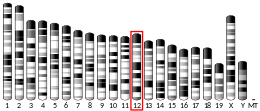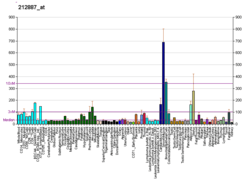SEC23A
Sec23 homolog A (S. cerevisiae), also known as SEC23A, is a protein which in humans is encoded by the SEC23A gene.[5]
Function
The protein encoded by this gene is a member of the SEC23 subfamily of the SEC23/SEC24 family. It contains a gelsolin domain.[6] It is part of a protein complex and found in the ribosome-free transitional face of the endoplasmic reticulum (ER) and associated vesicles. This protein has similarity to yeast Sec23p component of COPII. COPII is the coat protein complex responsible for vesicle budding from the ER. The encoded protein is suggested to play a role in the ER-Golgi protein trafficking.[5]
Interactions
SEC23A has been shown to interact with SEC24C,[7] Sec16A/p250 and iPLA1β/p125.[8]
Sec23 has also been shown to interact with TRAPPⅠ, Grh1p also known as GRASP65 and Dynactin. Because they are involved in anterograde vesicle transport from ER to Golgi, Sec23 is involved in vesicle transport.[9]
References
- GRCh38: Ensembl release 89: ENSG00000100934 - Ensembl, May 2017
- GRCm38: Ensembl release 89: ENSMUSG00000020986 - Ensembl, May 2017
- "Human PubMed Reference:". National Center for Biotechnology Information, U.S. National Library of Medicine.
- "Mouse PubMed Reference:". National Center for Biotechnology Information, U.S. National Library of Medicine.
- "Entrez Gene: SEC23A Sec23 homolog A (S. cerevisiae)".
- Ghoshdastider, U; Popp, D; Burtnick, L. D.; Robinson, R. C. (2013). "The expanding superfamily of gelsolin homology domain proteins". Cytoskeleton. 70 (11): 775–95. doi:10.1002/cm.21149. PMID 24155256.
- Pagano A, Letourneur F, Garcia-Estefania D, Carpentier JL, Orci L, Paccaud JP (Mar 1999). "Sec24 proteins and sorting at the endoplasmic reticulum". J. Biol. Chem. 274 (12): 7833–40. doi:10.1074/jbc.274.12.7833. PMID 10075675.
- p125 is localized in endoplasmic reticulum exit sites and involved in their organization.
- Coordination of COPII vesicle trafficking by Sec23.
Further reading
- Paccaud JP, Reith W, Carpentier JL, Ravazzola M, Amherdt M, Schekman R, Orci L (1996). "Cloning and functional characterization of mammalian homologues of the COPII component Sec23". Mol. Biol. Cell. 7 (10): 1535–46. doi:10.1091/mbc.7.10.1535. PMC 276004. PMID 8898360.
- Pagano A, Letourneur F, Garcia-Estefania D, Carpentier JL, Orci L, Paccaud JP (1999). "Sec24 proteins and sorting at the endoplasmic reticulum". J. Biol. Chem. 274 (12): 7833–40. doi:10.1074/jbc.274.12.7833. PMID 10075675.
- Tang BL, Kausalya J, Low DY, Lock ML, Hong W (1999). "A family of mammalian proteins homologous to yeast Sec24p". Biochem. Biophys. Res. Commun. 258 (3): 679–84. doi:10.1006/bbrc.1999.0574. PMID 10329445.
- Boyadjiev SA, Justice CM, Eyaid W, McKusick VA, Lachman RS, Chowdry AB, Jabak M, Zwaan J, Wilson AF, Jabs EW (2003). "A novel dysmorphic syndrome with open calvarial sutures and sutural cataracts maps to chromosome 14q13-q21". Hum. Genet. 113 (1): 1–9. doi:10.1007/s00439-003-0932-6. PMID 12677423.
- Dudognon P, Maeder-Garavaglia C, Carpentier JL, Paccaud JP (2004). "Regulation of a COPII component by cytosolic O-glycosylation during mitosis". FEBS Lett. 561 (1–3): 44–50. doi:10.1016/S0014-5793(04)00109-7. PMID 15013749.
- Watson P, Forster R, Palmer KJ, Pepperkok R, Stephens DJ (2005). "Coupling of ER exit to microtubules through direct interaction of COPII with dynactin". Nat. Cell Biol. 7 (1): 48–55. doi:10.1038/ncb1206. PMC 1592520. PMID 15580264.
- Palmer KJ, Konkel JE, Stephens DJ (2005). "PCTAIRE protein kinases interact directly with the COPII complex and modulate secretory cargo transport". J. Cell Sci. 118 (Pt 17): 3839–47. doi:10.1242/jcs.02496. PMID 16091426.
- Boyadjiev SA, Fromme JC, Ben J, Chong SS, Nauta C, Hur DJ, Zhang G, Hamamoto S, Schekman R, Ravazzola M, Orci L, Eyaid W (2006). "Cranio-lenticulo-sutural dysplasia is caused by a SEC23A mutation leading to abnormal endoplasmic-reticulum-to-Golgi trafficking". Nat. Genet. 38 (10): 1192–7. doi:10.1038/ng1876. PMID 16980979.
- Tu LC, Yan X, Hood L, Lin B (2007). "Proteomics analysis of the interactome of N-myc downstream regulated gene 1 and its interactions with the androgen response program in prostate cancer cells". Mol. Cell. Proteomics. 6 (4): 575–88. doi:10.1074/mcp.M600249-MCP200. PMID 17220478.
External links
- PDBe-KB provides an overview of all the structure information available in the PDB for Human Protein transport protein Sec23A








